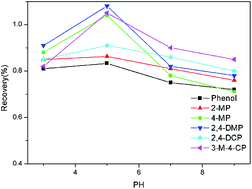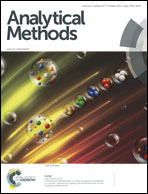Evaluation of Fe3O4@SiO2–MOF-177 as an advantageous adsorbent for magnetic solid-phase extraction of phenols in environmental water samples†
Abstract
Metal–organic frameworks (MOFs), a novel class of hybrid inorganic–organic materials, possess high surface area, good thermal stability and selectivity, and thus have great potential for use as sorbent materials. MOF-177 is attractive for its large pores, high adsorptivity and selectivity, which has rarely been used in analytical science. Herein a facile magnetization of MOF-177 for rapid magnetic solid phase extraction of phenols from environmental water samples was studied, with analysis using gas chromatography-mass spectrometry. The magnetization of MOF-177 microcrystals as well as solid-phase extraction (SPE) of phenols was achieved simultaneously by mixing MOF-177 and Fe3O4@SiO2 microparticles in the water sample under sonication. Under the optimized conditions, the developed method showed good linearity within the range of 1–200 μg L−1, low detection limits (16.8–208.3 ng L−1) and quantitation limits (56.0–694.2 ng L−1). The recoveries are between 83.3 and 108.7% with the spiked level of 25 μg L−1. The results demonstrated that the Fe3O4@SiO2–MOF-177 magnetic microspheres are promising sorbents in the MSPE field in environmental samples.


 Please wait while we load your content...
Please wait while we load your content...